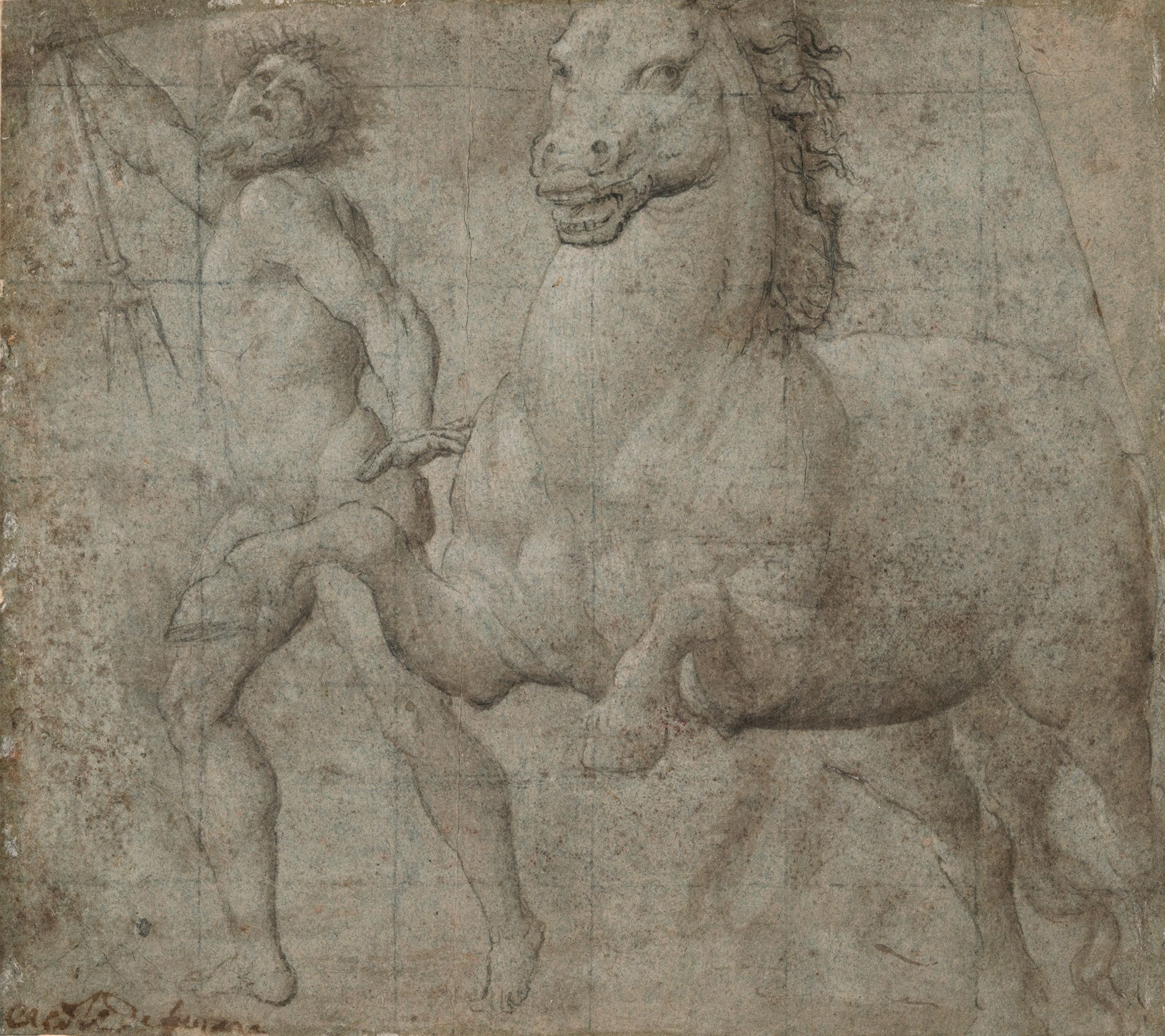FJK 076
Pordenone, Da (Giovanni Antonio Licinio) (Italian, Pordenone 1483?–1539 Ferrara)
Neptune and Rearing Horse
ca. 1532-1535
6 3/8 × 7 9/32 in. (162 × 185 mm)
Medium
Pen, brown ink and wash with white highlights on bluish paper, squared in black chalk for transfert, reverse rubbed with black chalk powder
Illegible old inscription in pen and brown ink bottom left
Number in charcoal from Alister Mathews Collection on paper support partly cut from W. Young Ottley Collection
Origin
W. Young Ottley Collection (1771-1836)
Dr. and Mrs. Victor Bloch Collection, London
Their sale, Sotheby’s, London, November 12, 1964, no. 126 (under Venetian school, early 16th century)
Alister Mathews Collection
Sale, Sotheby’s, London, July 8, 2004, no. 22
Jan Krugier Collection, Monaco, JK 6272
Jan Krugier Foundation
Bibliography
COHEN Charles E., The Drawings of Giovanni Antonio da Pordenone, Florence: La Nuova Italia Editrice, 1980, p. 86, fig. 103.
FURLAN Caterina, Il Pordenone, Milan: Electa, 1988, p. 298, mentioned under no. D. 61, p. 299.
COHEN Charles E., The Art of Giovanni Antonio da Pordenone, Cambridge University Press, 1996, vol. I, pp. 343-344, 498, 502, note 26; vol. II, p. 889, fig. 519.
Exhibitions
Munich, Kunsthalle der Hypo-Kulturstiftung, Das Ewige Auge - Von Rembrandt bis Picasso. Meisterwerke aus der Sammlung Jan Krugier und Marie-Anne Krugier-Poniatowski, 2007, p. 78, no. 31, color ill. p. 79.
Notes
This very exciting drawing which represents a handsome, rather vigorous and sturdy, rearing horse, with Neptune running beside him holding a trident and wearing only a forceful expression, has always been associated with Pordenone’s drawing, The Conversion of St. Paul, now in the Pierpont Morgan Library, in which a very similar horse and running figure appear to the left of the composition (see Charles E. Cohen, The Art of Giovanni Antonio da Pordenone, Cambridge 1996, vol I, pp. 342-45, vol II, fig. 518). Cohen has pointed out the fame achieved by this powerful composition, so typical of Pordenone’s style: “What is remarkable is the extent to which the Morgan and possibly related compositions were one of the chief vehicles for Pordenone’s enormous influence in Venice and the Veneto from the late 1530s until the early 1550s” (Cohen, op. cit., vol. I, p 345). It seems that Pordenone was called upon to do such “saggi di bravura” (Cohen, op. cit., vol. I, p. 343) for his Venetian patrons and the present drawing is another example of his bold foreshortening and forceful and dramatic compositions. The Morgan drawing is generally dated around 1532-1535 and must have been preparatory for a well-known work. Our study must be of a similar date as it shares not only compositional similarities but also stylistic ones. In the Andrea Vendramin collection there were two paintings (today known only from drawn copies, Cohen, op cit., vol. II, figs. 520-521) depicting two details from the same composition as the Morgan drawing : the man with the rearing horse to the left and the cavalier on horseback to the right. The present drawing cannot be related to any known commission by the artist, but might easily have been for one of Pordenone’s façade decorations such as that of the Palazzo d’Anna, Venice, for which a preparatory drawing has survived (Victoria and Albert Museum, inv. 2306, Cohen, op. cit., vol. II, fig 587).
Sotheby’s, Old Master Drawings, London July 2004
Request for information/loan
The Jan Krugier Foundation is devoted to increasing the impact of the collection of drawings through regular loans to major exhibitions. Loan applications should include a complete presentation of the project.

